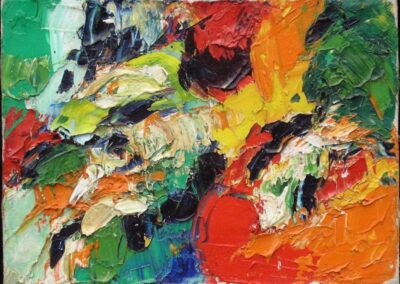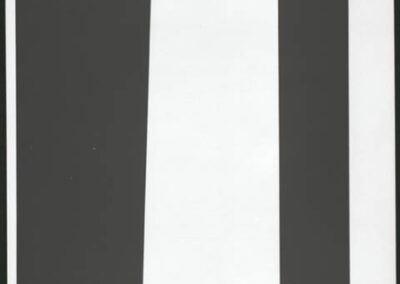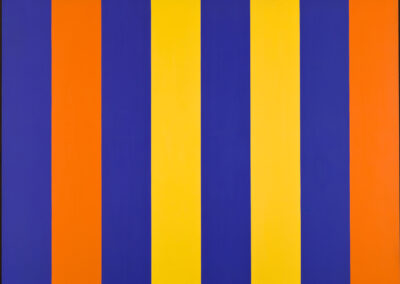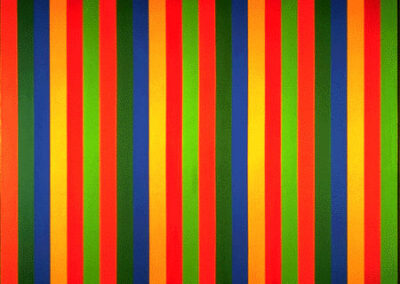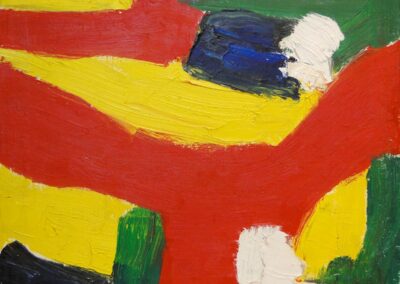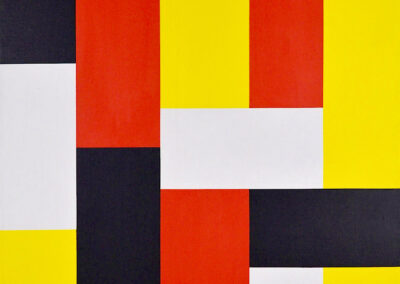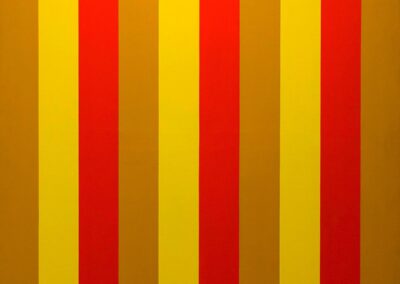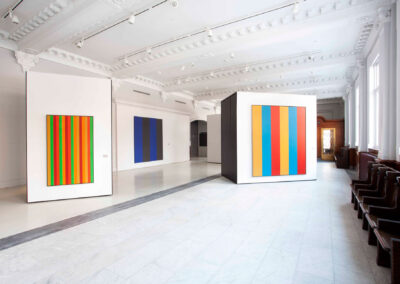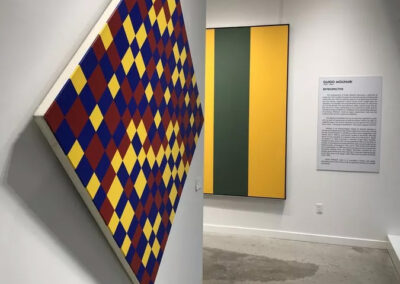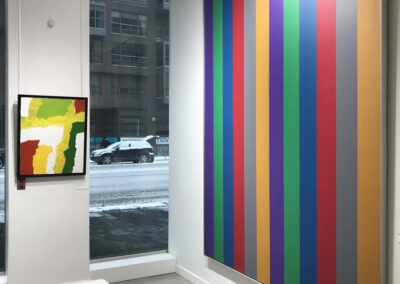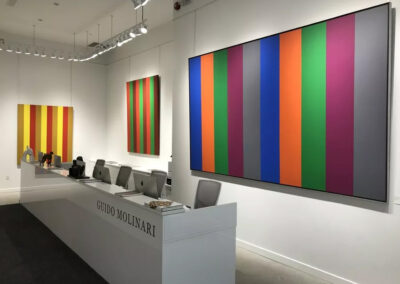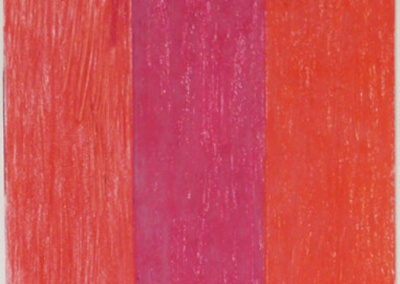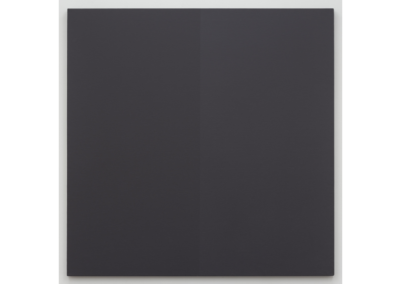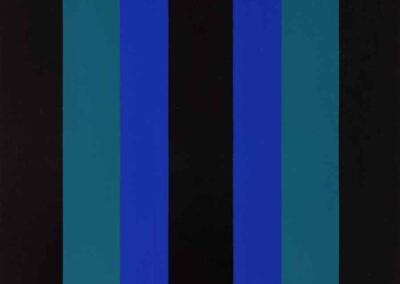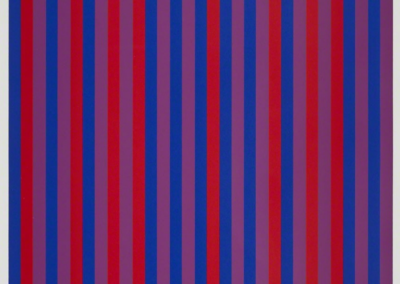Our next Artist You Need To Know is Guido Molinari (1933 – 2004).
Molinari was a Canadian artist who was known internationally for his serial abstract paintings that were often massive and explored hard edged abstraction. “Considered one of the most influential artists in contemporary Canadian art, Guido Molinari has made an important contribution to the advancement of non-figurative painting. Painter, artist, art critic and theoretician, he participated in debates raising the fundamental question of abstraction and, during the 1950s, laid the foundations for a demanding reflection on the specificity of pictorial space.” (from Musée d’art contemporain de Montréal)
“There is no such thing as a colour,” Molinari once declared, in speaking of his approach to artmaking, “there are only colour harmonies. A given colour exists only in its shape and dimensions – and in its correlation with other colours.”
He was born in Montréal, Québec, to parents who had emigrated to Canada from Italy. From a young age (13) Molinari was painting : his artistic sensibility – which has been described as ‘existentialist’ – was shaped early in life, as at 16 he contracted tuberculosis and while recuperating he read Nietzsche, Sartre, Piaget, and Camus. Later he would attend the École des beaux-arts de Montréal (1948-1950) and the Montreal Museum of Fine Arts (1951), studying with Marian Scott and Gordon Webber.
At that time he began making drawings and paintings combining automatic methods – a somewhat prescribed approach to painting aimed at freeing the subconscious – with a disciplined approach and was among the leaders of Québec’s nascent abstract painters during the era leading up to – and including – the Quiet Revolution in that province.
For a time Molinari was in New York City and was directly inspired by the works of Barnett Newman and Jackson Pollock. Like many of his fellow Québec visual artists of this period, Molinari was engaged with – and strongly influenced by – the American and European contemporary art scenes, and this informed his own artwork, teaching and critical writings.
When he returned to Montreal he founded the Galerie L’Actuelle and in 1956 Molinari was a founding member of the Association des Artistes Non – Figuratifs de Montreal. Molinari’s paintings – from the 1960s onward, as his style and aesthetic matured – employed “vertical, hard-edged bands of colour. Pictorial space in these paintings was created by the spectator’s perception of the shifting and mixing of colours.” (from here)
He exhibited at the Biennale in Venice in 1968 and participated in the Paris Biennale in 1977. Molinari was awarded The Montreal Museum of Fine Arts Jessie Dow award (1962), The Royal Canadian Academy of Art Award (1965), The Guggenheim Fellowship Scholarship (1967), The David E. Bright Foundation Award (1968 at The Venice Biennale), and the Prix Paul Emile- Borduas (1980).
Guido Molinari was very influential as a teacher as well : for nearly three decades he taught at Sir George Williams University and Concordia University. He retired from this position in 1997. He “exerted a powerful influence on younger artists, through his teaching, his theoretical writing and his opinions, firmly held and strongly stated.” (from here)
Molinari’s work can be found in a number of collections, and his exhibition record is equally impressive. More information on both of these fronts can be found at the site for Foundation Guido Molinari. Notable exhibitions include shows at the National Gallery of Canada, the Musée d’art contemporain de Montréal (a retrospective mounted in 1995), the Guggenheim Museum and the Museum of Modern Art in New York.
Similar to how Molinari was significant as a teacher as well as an artist, he was also an avid art collector, especially as pertains to his research in abstraction and modernism. His collection included Piet Mondrian`s original definition of Neo-Plasticism (1926 – and Molinari was associated with Plastician artists such as his contemporaries Rita Letendre and Yves Gaucher), Henri Matisse, John Cage, Jasper Johns, Barnett Newman, Richard Serra, Francis Bacon, Piet Mondrian and Ellsworth Kelly. He also collected Québec artists such as Denis Juneau, John Lyman and Ozias Leduc.
.
Much more of his work and more about Molinari – and his legacy – can be seen here at the Foundation Guido Molinari. The Foundation is “a vital Montreal arts institution whose existence originates with the generous legacy from the artist. The Foundation aims to promote and perpetuate Molinari’s work by converting his last studio/residence, located in a former bank, into an exhibition, conference and documentation center where works are shown and created to advance the careers of emerging artists.”
Guido Molinari passed away in 2004 in Montréal from complications from pneumonia after fighting a cancer diagnosis.
In 2004, Concordia recognized him with a posthumous honorary doctorate. When a retrospective exhibition of Molinari’s artwork was mounted at Galerie Simon Blais, Canadian Art Magazine offered Molinari’s words as a summation of his life and practice : “And the story is this – that what might at first appear as one thing is, in fact, a very complicated experience.”


